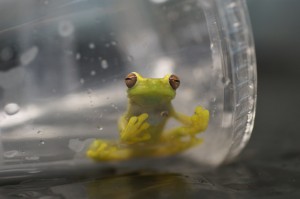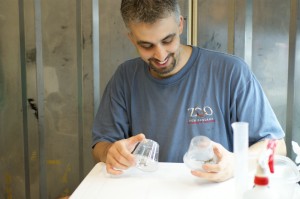The Darien conjures up so many different mental images. At nearly 6,000km2 this National Park and World Heritage site represents one of Central America’s largest remaining wilderness areas. It is full of charismatic wildlife like harpy eagles, jaguars and endemic birds such as the beautiful tree-runner and the green-naped tanager. To many travelers, the Darien Gap is a dangerous blank spot on a map, filled with Columbian Rebels who thwart most overland journeys between the two great American continents. To historians, the Darien is the tomb of Scotland’s failed attempt at empire building where in the late 17th century, nearly 3,000 settlers failed to establish a hold for Scotland in the new world. And to many Panamanians, the Darien is a rural heartland for their country, inhabited by the Kuna, and Embera-Wounaan tribes who resisted the settlers.
To a herpetologist, the Darien region of Eastern Panama represents one of our last clear chances to conserve neotropical amphibians. This is because an invasive pathogen causing a deadly amphibian disease known as chytridiomycosis has been spreading through the highlands of Central and South America. The only place it hasn’t reached yet is Eastern Panama. The disease devastates amphibian populations without paying any heed to protected area boundaries and it has been implicated in more than 90 amphibian disappearances. One of the hardest hit groups are riotously colorful toads also known as Harlequin frogs. About 30 out of around 113 described species of Harlequin frogs are feared to be extinct, and 60-75 percent of all known species are experiencing rapid population declines. For this reason, the project considers the endemic toad Mountain Harlequin frog, Atelopus certus, as a top rescue priority.
Our 4.5-hour drive, 3-hour boat ride and 4 hours by horse, and 2-hour track on foot took us past many huts on stilts, cows, surly faced children and deep into the Darien National Park led by our Embera guide named Alonso. Soldiers prominently displaying AK47s on their hips manned frequent security checkpoints. They stood in front of wanted posters promising $300,000 rewards for information leading to the arrest of pictured FARC rebels, which gave me a clue as to why this area is so poorly explored from a herpetology standpoint. Our operation was divided into two teams. An advance monitoring team headed into the field a week earlier to complete the baseline monitoring of the frog community at upland and lowland sites. Our team followed as an international rescue team of the Panama Amphibian Rescue and Conservation Project’s partners tasked with collecting the frogs. We were also accompanied by a 2-man documentary film crew for Smithsonian Networks and a troupe of Embera porters who safely ferried our ungainly equipment over slippery waterfalls and muddy tracks.
On the first day, we immediately found several Atelopus certus males, emitting a low whistling sound from smooth-worn boulders around the rain-swollen mountain stream. Every 10-20m we found an incredulous orange-peel-colored frog with jet-black spots and white belly, vigorously defending his turf from competing males and calling hopefully for females. It turns out that males are much easier to find because they pretty much live by the stream waiting for females year-round. Females, on the other hand, only come down to the streamside when their rosy abdomens are engorged with eggs and they are ready to reproduce. This swiftly became a problem for us, because in order to get captive insurance populations started with good genetic representation of the species, we really needed at least 20 males and 20 females to start us off. On our first day we collected more than 30 males, but just one female, who we found staggering around on a boulder with a smaller, oblivious male clinging onto her back in a mating embrace. Clearly if we wanted more females, we were going to have to cover more ground or to change our strategy.

The Toad Mountain Harlequin Frog, Atelopus certus. Female left, male right.
The next day, we decided to focus on finding juvenile frogs that had just metamorphosed from tadpoles. The idea is that at least half of them should theoretically be female. Collecting juveniles has an added advantage from an assurance colony perspective, in that we can reliably age them. The problem was figuring out what they look like, and how to separate them from the numerous other dark, 5-mm toad metamorphs hopping around on the damp leaf piles on the stream bank. Edgardo Griffth soon gave us a lesson in juvenile toad identification, pointing out a small dark black frog half the size of your baby fingernail, but closer inspection revealed characteristic features—Atelopus froglets are covered in metallic green chevrons and have bright orange feet!
In all, we managed to find 50 males, 12 adult females and about 16 juveniles, from two sites. We ignored the vast majority of calling males, leaving them to continue their daily routines on Toad Mountain. Overall this was a very successful expedition compared to our attempts last year. In November 2009, we hoped to get ahead of the spreading disease wave in the Chagres watershed and targeted Atelopus limosus and Hyloscirtus colymba. When we arrived, however, we discovered that the site was at the peak of a massive disease outbreak. Frogs were difficult to find and 70 percent of all species were infected with chytridiomycosis. We lost many frogs despite having two veterinarians on board to give them daily anti-fungal treatments, and it was deeply upsetting to be thrust into the midst of such a harsh triage situation. Given this perspective, it was a real privilege for us all to witness a healthy, pre-decline population of Atelopus. Our pro-active approach to get ahead of the disease wave made finding the animals and getting them situated in captive conditions much easier, with no mortalities in the first week.
We gratefully acknowledge funding for this expedition from the US Fish and Wildlife Service, Wildlife Without Borders Program, and by the Mohamed bin Zayed Species Conservation Fund.


